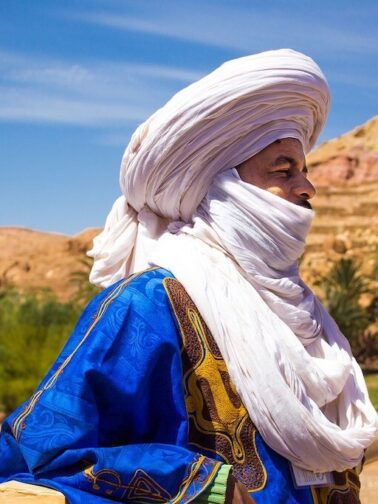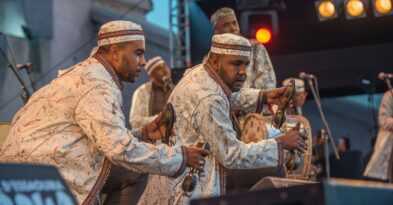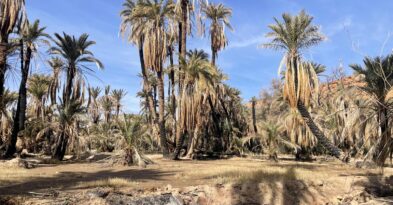The Culture of Morocco
Nestled in northwest Africa, the Kingdom of Morocco is caressed by the Mediterranean’s gentle waves and the Atlantic’s rolling surf. Its Arabic name “Maghreb al-Aqsa” translates to “Land where the Sun Sets,” a territory that has always been a crucible of civilizations: from Carthaginian ruins to Roman colonnades, from Berber tribes to Spanish colonists, countless cultures have collided here creating brilliant sparks.
Local residents uphold hospitality rooted in the Quran, though travelers should note that assistance (like directions or photos) often carries implicit expectations of compensation. Newcomers may need time to adapt to the unhurried pace of life—the concept of “hurry” remains foreign here, replaced by sun-drenched tranquility. Islamic principles form the foundation of social conduct, with customs that may appear “strict” to visitors (alcohol restrictions, Ramadan quietude) being natural expressions of faith. Only by slowing one’s pace can travelers truly decipher this nation that maintains such elegant equilibrium between tradition and modernity.
Rules of conduct in Morocco
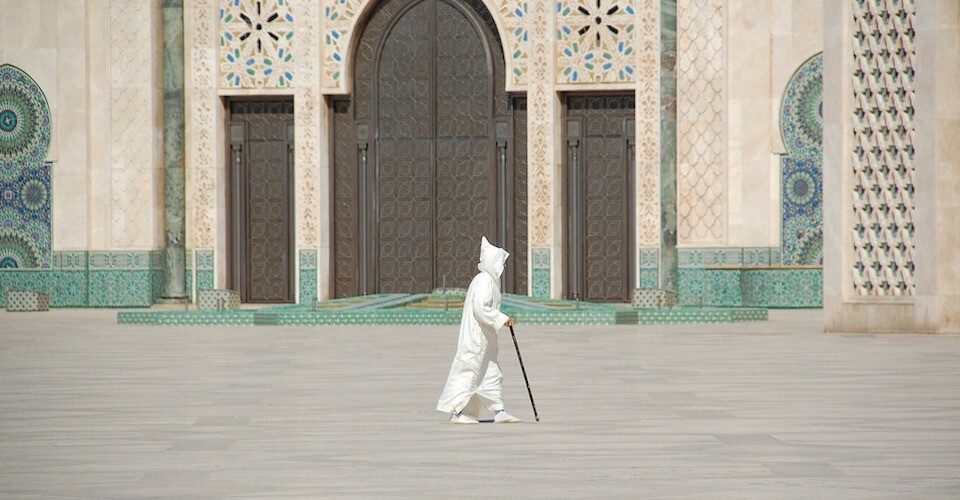
On the streets of Morocco, excessive public displays of affection such as embracing and romantic kissing are generally frowned upon. Women are advised to avoid wearing revealing clothing to align with local norms. When interacting with residents, it’s considered polite to inquire about their health and family matters, as these questions are seen as gestures of genuine warmth and connection.
Special attention should be paid to tea ceremony etiquette: refusing a freshly brewed mint tea offered by your host would be viewed as a profound disrespect to their hospitality. At dining tables, people strictly follow the tradition of using only the right hand for eating—specifically employing three fingers to handle food, while the left hand remains discreetly away from meals. Bread holds particular significance here; beyond being a dietary staple, it represents prosperity and abundance, thus treated with conscious moderation and profound respect.
Morocco’s cultural landscape displays remarkable diversity, deeply influenced by geographical conditions. While nomadic tribes in remote mountainous areas and coastal communities share certain cultural roots, the harsh desert environment has forged a resilient and straightforward character, contrasting sharply with the open-minded flexibility nurtured by maritime civilization. This cultural mosaic preserves the blended heritage of Berber, Arab, African, and European influences, while simultaneously maintaining distinctive regional variations that color every aspect of daily life.
Decorative and applied arts in Morocco
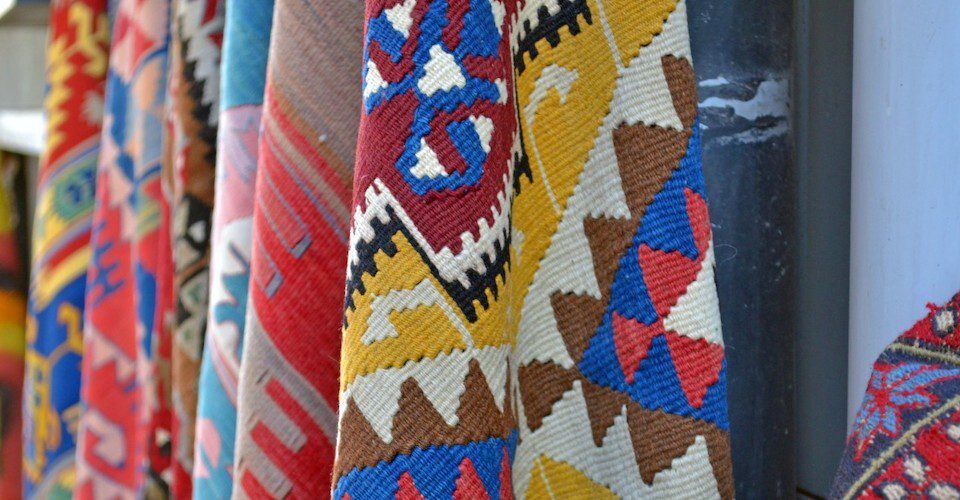
Moroccan markets resemble a living museum of art, filled with masterpieces blending African tribal motifs and Arabesque patterns. The nation’s proudest treasure remains the handwoven carpets carrying millennia of wisdom. In traditional culture, young women skilled in carpet weaving are considered ideal marriage partners, for each rug represents the interweaving of wool and life itself.
The art of carpet weaving has long been a coded language passed down through matrilineal lines. Moroccan women, often with limited freedom, channeled unspoken emotions into warp and weft: vine patterns whisper longing, geometric shapes conceal protective talismans, and architectural outlines preserve hometown memories. Each carpet becomes a love letter written in wool, with colors sourced from nature—red from poppies, blue from indigo ore, yellow from saffron.
From the intricate knotted pile rugs of Rabat to the rugged Berber weaves of the Atlas Mountains, every city possesses unique techniques. The renowned Rabat carpets, requiring months of labor per square meter, hold value comparable to masterpiece paintings—becoming tangible epic poems of heritage.
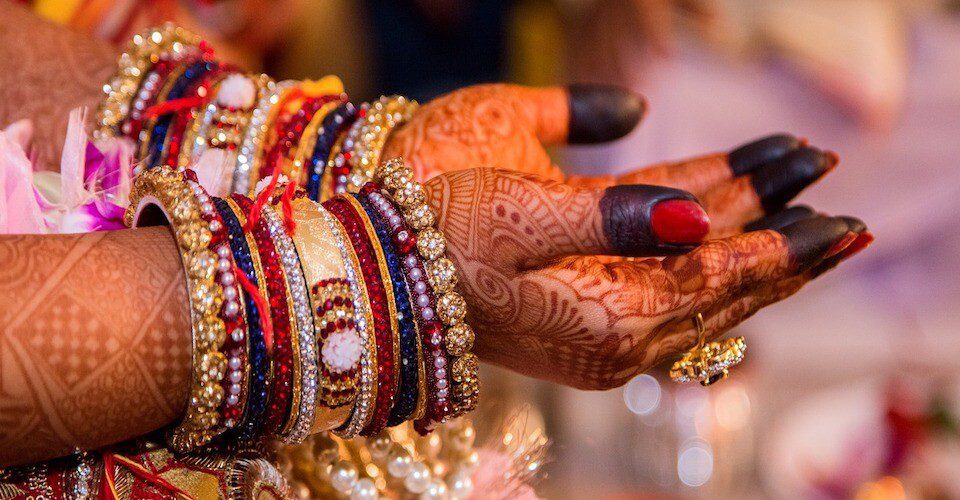
In Morocco, jewelry serves as a significant marker of a woman’s social status. These intricately crafted pieces, primarily fashioned from silver or gold, form a unique cultural landscape where male artisans specialize in metalwork while women excel in carpet weaving. Both crafts are cherished family traditions, with secrets passed down from father to son and mother to daughter through generations.
Moroccan jewelry art displays two distinct stylistic lineages:
Berber Style: Characterized by restrained color palettes and simple forms adorned with diverse symbolic ornaments
Hispano-Moorish Style: Renowned for its ornate openness and mastery in filling available spaces with intricate patterns
The craft of leatherworking represents another centuries-old heritage. The ancient city of Fez, the capital of leather production, still preserves medieval manufacturing techniques:
Manual dyeing using natural pigments
Repeated washing in wooden vats
Specialized soaking solutions for softening
Sun-drying processes that create unique textures
Wandering through Moroccan souks feels like stepping into a page from One Thousand and One Nights: Pointed babouche slippers with coiled patterns, leather lamps studded with brass nails, natural cosmetics infused with saffron, fragrant spice mounds emitting scents of oud and amber…
In the medinas of Fez, Marrakech, and Meknes, artisans assemble dazzling mosaic tables from colored ceramic fragments, their geometric patterns carrying the mathematical wisdom of Moorish civilization.
Notably, beneath the predominant Islamic culture, ancient shamanistic traditions remain active. In secluded market corners, one discovers: Silver “Hand of Fatima” amulets against the evil eye, ritual powders blended from desert plants, parchment scrolls inscribed with protective verses, painted glass bottles containing ceremonial potions…
This blending of traditions presents Morocco’s most captivating paradox—a society that strictly observes Islamic principles while preserving secret spaces for ancient animist beliefs.
【In Morocco】
The gender division in crafts reflects the ancient social structure of “male metallurgy, female textiles”
The six-century-old leather dyeing vats remain functional due to ancestral biological tanning formulas
Mosaic artistry derives from Moorish architectural traditions, transforming geometry into visual feasts
Talisman culture merges Islamic calligraphy with primordial Berber totemic worship
Holidays, festivals and ceremonies in Morocco
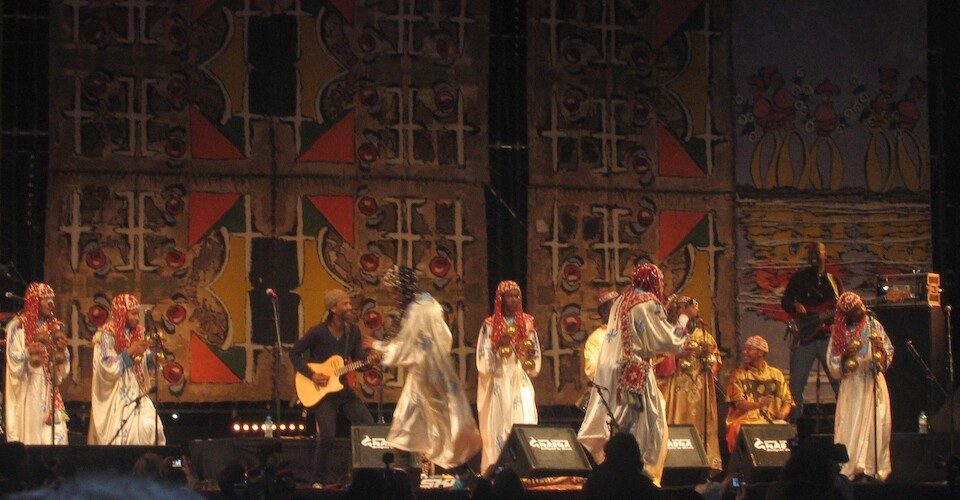
In the Kingdom of Morocco, the holiday system is deeply rooted in the Islamic lunar calendar. While religious observances are celebrated with profound reverence, civil holidays like Independence Day and Revolution Day are often marked with comparative modesty.
Ramadan – The Sacred Season of Spiritual Reflection
As the most significant period in the Muslim world, Ramadan creates a unique rhythm of daily life:
Strict fasting from dawn to dusk, abstaining from all food, drink, and smoking
Enhanced frequency of prayers with mosques illuminated throughout the night
Traditional cannon fire at sunset announcing Iftar, instantly transforming cities into vibrant hubs
Night markets brimming with culinary delights and tea houses hosting social gatherings until late hours
This diurnal alternation between abstinence and celebration beautifully embodies the religious philosophy of self-discipline and communal joy.
Marrakech Popular Arts Festival – A Cultural Heritage Extravaganza
Held annually at the historic El Badia Palace ruins during summer-autumn transition, this festival represents a pinnacle of cultural celebration:
Dozens of folk troupes showcasing intangible heritage including Berber drumming and Atlas mountain chants
Artisans demonstrating ancient techniques like lost-wax silver casting and clay-based leather tanning
Open-air theaters featuring daily performances of Sufi whirling dances and Arab rope acrobatics
This two-week spiritual feast has been recognized by UNESCO as a world-class intangible cultural heritage event.
Seasonal Festival Calendar
March: Valley of the Roses Festival – Fragrant celebrations amidst petal showers
June: Essaouira Gnaoua World Music Festival – Fusion of African spirituals and jazz rhythms
September: Fes Festival of World Sacred Music – Celestial harmonies in ancient urban labyrinths
October: Merzouga Desert Marathon – Challenging the crimson Sahara dunes
December: Marrakech Sufi Culture Festival – Contemporary interpretations of mystical poetry
These celebrations serve as living repositories of ancient traditions while providing vibrant platforms for cross-cultural dialogue, collectively weaving the millennial cultural fabric of this North African kingdom.
【In Morocco】
The Islamic calendar’s annual 11-day shift causes religious holidays to rotate through solar years
The El Badia Palace ruins, symbolic of the 16th-century Saadi dynasty, provide historical resonance to the arts festival
Gnaoua music traces its origins to West African slave trade routes, now recognized as a significant world music genre
The Rose Festival sustains the century-old rose cultivation industry in Dades Valley, where one ton of petals yields merely one kilogram of precious essential oil
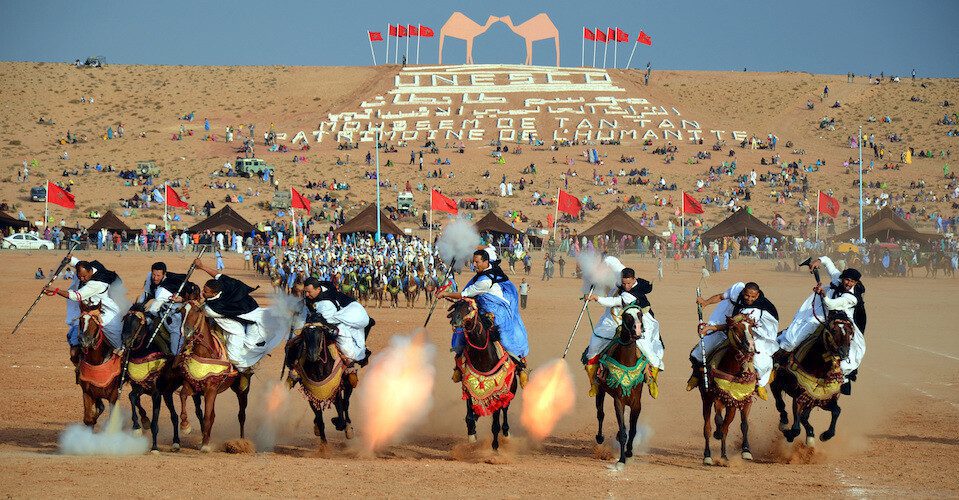
In Morocco, the Moussem represents a distinctive religious holiday with strong local characteristics, resembling cultural pearls scattered across the land. These festivals follow specific dates in the Islamic calendar, with nearly 650 Moussem celebrations occurring nationwide throughout the year, creating a flowing cultural feast. Each Moussem revolves around particular themes: commemorating sacred events of Islamic prophets, honoring legendary historical figures, or celebrating local symbols (such as Honey Festival, Camel Festival, etc).
During celebrations, three cultural dimensions unfold:
Religious Rituals: Believers in white djellabas gather for collective prayers while Sufi practitioners chant ancient scriptures
Commercial Fairs: Caravan trade scenes from millennia past reappear, showcasing handicrafts and agricultural specialties
Cultural Performances: Equestrian jousting, traditional illusion acts, and fire dances featuring intangible heritage skills
Among the most renowned are:
Tan-Tan Moussem: A Sahara cultural gathering inscribed on UNESCO’s Intangible Heritage list
Fes Prophet’s Birthday Celebration: Religious processions filling streets with millions
Imilchil Camel Festival: Bedouin “beauty pageant” for desert ships
Meanwhile, Moroccan weddings embody real-life scenes from One Thousand and One Nights, blending ancient traditions with modern emotions:
Pre-wedding Rituals:
Henna Night: Brides’ hands adorned with fertility symbolism vine patterns
Dowry Display: Dates and milk on silver trays symbolizing sweet beginnings
Wedding Ceremonies:
Brides change through 7 traditional outfits, from Berber dresses adorned with gold coins to heavily embroidered kaftans
Processions carrying bridal thrones scatter rose petals and almonds
Cultural Preservation:
While modern youth enjoy mate selection freedom, marriage remains “the union of two families”
Marriage proposals require “Aqil” (matchmakers) with Quran as witness
Marriage contracts must follow Maliki school jurisprudence
In Marrakech’s palace courtyards, when Gnawa musicians strike bronze cymbals and newlyweds receive blessings wearing jasmine garlands, time seems to fold, recreating magical scenes from Aladdin in the twenty-first century.
【In Morocco】
The word “Moussem” derives from Arabic “mawsim” meaning “seasonal gathering”
Wedding costume changes symbolize the bride’s transition through different life stages
The traditional “Amariya” bridal throne requires six male relatives to carry
Moussem fairs serve as crucial platforms for preserving endangered Berber crafts
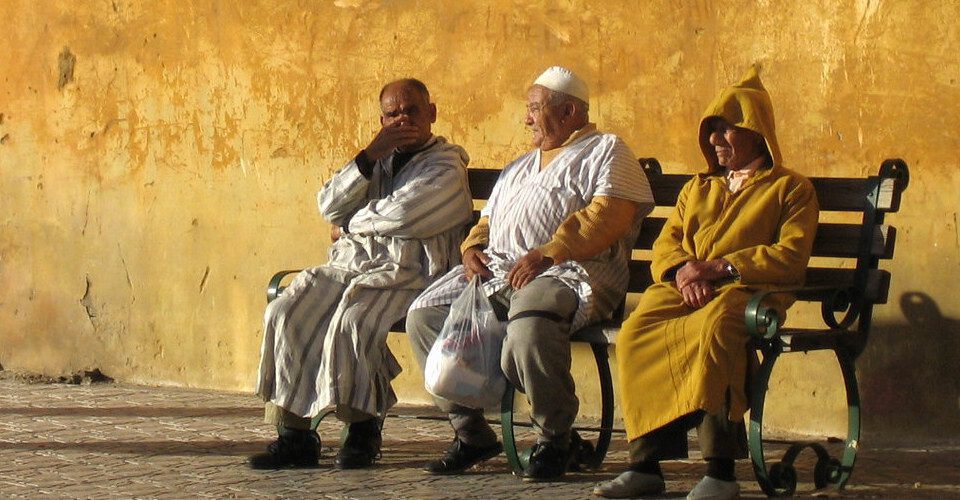
In Morocco, history is not confined to museums but vibrantly flows through winding alleys and bustling squares. The storytellers seated in ancient medina squares are like living repositories of civilization, recounting original tales from One Thousand and One Nights with dramatic cadence. Their furrowed brows hold Berber creation myths, while their drumbeats echo epic poems of Arab caravans—this oral tradition is recognized by UNESCO as “living human heritage.”
The nation’s cultural code reveals itself through three dimensions:
Dynastic Memory on Currency: With each new monarch’s ascension, banknotes subtly transition portraits—from the profile of Hassan II to the smile of Mohammed VI—documenting dynastic evolution in palm-sized artifacts
Colonial Imprint in Linguistics: Arabic serves as the bond of faith, French symbolizes elite communication, while the Berber language with its lost script continues to be secretly transmitted among mountain communities
Millennial Wisdom in Souks: At Marrakech’s Djemaa el-Fna square, bargaining becomes performance art. Merchants anticipate your recognition of the humor behind “astronomical” initial quotes, where sophisticated negotiation resembles chess—culminating in shared smiles and mutual mint tea offerings upon agreement
When traversing the snow-capped Atlas peaks only to encounter the rose-gold dunes of the Sahara; when getting lost in Fez’s 6,000 alleys then discovering blue-and-white fishing villages along the Atlantic coast—these extreme contrasts embody Morocco’s magic. It’s where veiled Berber women negotiate business via smartphones, and where earthen kasbahs resonate with the electric chants of Gnawa bands.
Contact us for more travel information!

